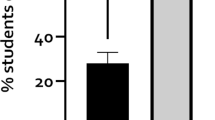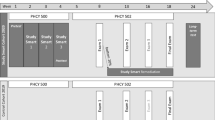Abstract
Near-peer teaching (NPT) is a peer-assisted learning method that has been adopted by medical schools as studies have reported benefits to both tutors and tutees. Published studies suggest students may benefit from NPT programs when preparing for the US Medical Licensing Examination (USMLE) Step 1 exam, but they did not use a randomized controlled trial methodology. To determine the impact of a year-long NPT preparation program for the Step 1 examination, we conducted a randomized-controlled trial among second-year medical students at New York Medical College during the 2017–2018 and 2018–2019 academic years. Students who enrolled in the study were invited to complete a post-exam survey, and Step 1 examination scores of intervention and control groups were compared, controlling for preexisting academic differences and demographic traits. While the majority of students reported NPT program participation was a valuable use of their time, we found no significant difference in Step 1 scores between intervention and control groups. Notably, students identifying as female, underrepresented in medicine (UIM) or socioeconomically disadvantaged (SED) enrolled in higher proportions compared to the combined M2 student body of the 2017–2018 and 2018–2019 academic years. Our results may highlight the limitations of NPT programs for board examination preparation and inform the future design of peer-assisted learning programs within medical schools.


Similar content being viewed by others
Data Availability
Anonymized datasets generated during and/or analyzed during the current study are available from the corresponding author on reasonable request.
References
Allen VL, Feldman RS. Learning through tutoring. J Exp Educ Routledge. 1973;42:1–5.
Buckley S, Zamora J. Effects of participation in a cross year peer tutoring programme in clinical examination skills on volunteer tutors’ skills and attitudes towards teachers and teaching. BMC Med Educ. 2007;7:20.
Schmidt HG, Moust JHC. What makes a tutor effective? A structural equations modelling approach to learning in problem-based curricula [Internet]. ERIC; 1995 [cited 2021 Feb 2]. Available from: https://eric.ed.gov/?id=ED385189.
Lockspeiser TM, O’Sullivan P, Teherani A, Muller J. Understanding the experience of being taught by peers: the value of social and cognitive congruence. Adv Health Sci Educ Theory Pract. 2008;13:361–72.
Nelson AJ, Nelson SV, Linn AMJ, Raw LE, Kildea HB, Tonkin AL. Tomorrow’s educators… today? Implementing near-peer teaching for medical students. Med Teach Taylor & Francis. 2013;35:156–9.
Shankar PR, Singh B, Singh AK, Karki BS, Thapa TP. Student perception about peer-assisted learning sessions in a medical school in Nepal. 2011. Available from: https://static.webmedcentral.com/article_view/2459.
Hall S, Stephens J, Andrade T, Davids J, Powell M, Border S. Perceptions of junior doctors and undergraduate medical students as anatomy teachers: investigating distance along the near-peer teaching spectrum. Anat Sci Educ Wiley Online Library. 2014;7:242–7.
Shenoy A, Petersen KH. Peer Tutoring in Preclinical Medical Education: A Review of the Literature [Internet]. Medical Science Educator. 2020. p. 537–44. Available from: https://doi.org/10.1007/s40670-019-00895-y.
Gallan AJ, Offner GD, Symes K. Vertical integration of biochemistry and clinical medicine using a near-peer learning model. Biochem Mol Biol Educ. Wiley Online Library; 2016;44:507–16.
Jackson TA, Evans DJR. Can medical students teach? A near-peer-led teaching program for year 1 students. Adv Physiol Educ. 2012;36:192–6.
Green M, Jones P, Thomas JX Jr. Selection criteria for residency: results of a national program directors survey. Acad Med. 2009;84:362–7.
Weissbart SJ, Stock JA, Wein AJ. Program directors’ criteria for selection into urology residency. Urology. 2015;85:731–6.
United States Medical Licensing Examination [Internet]. [cited 2020 Sep 12]. Available from: https://usmle.org/incus/.
Negaard M, Assimacopoulos E, Harland K, Van Heukelom J. Emergency medicine residency selection criteria: an update and comparison. AEM Educ Train. 2018;2:146–53.
Mitsouras K, Dong F, Safaoui MN, Helf SC. Student academic performance factors affecting matching into first-choice residency and competitive specialties. BMC Med Educ. Springer; 2019;19:241.
Raman T, Alrabaa RG, Sood A, Maloof P, Benevenia J, Berberian W. Does residency selection criteria predict performance in orthopaedic surgery residency? Clin Orthop Relat Res Springer. 2016;474:908–14.
Sharma A, Schauer DP, Kelleher M, Kinnear B, Sall D, Warm E. USMLE Step 2 CK: Best predictor of multimodal performance in an internal medicine residency. J Grad Med Educ. meridian.allenpress.com; 2019;11:412–9.
Moynahan KF. The current use of United States Medical Licensing Examination Step 1 Scores: holistic admissions and student well-being are in the balance. Acad Med. 2018;93:963–5.
Slavin SJ, Chibnall JT. Finding the Why, Changing the How: Improving the Mental Health of Medical Students, Residents, and Physicians. Acad. Med. 2016;1194–6.
Rubright JD, Jodoin M, Barone MA. Examining demographics, prior academic performance, and United States Medical Licensing Examination Scores. Acad Med. 2019;94:364–70.
Ten Cate O, Durning S. Peer teaching in medical education: twelve reasons to move from theory to practice. Med Teach. 2007;29:591–9.
Alcamo AM, Davids AR, Way DP, Joanne Lynn D, Vandre DD. The Impact of a Peer-Designed and -Led USMLE Step 1 Review Course: Improvement in Preparation and Scores [Internet]. Academic Medicine. 2010:S45–8. Available from: https://doi.org/10.1097/acm.0b013e3181ed1cb9.
Tanenbaum EJ, Johnson JH, Jordan E, Cottral J, Tenore C, Burton WB, et al. An effective evidence-based student run near-peer support group for the USMLE Step 1 Exam. Medical Science Educator. 2016;26:691–9.
Blank WA, Blankenfeld H, Vogelmann R, Linde K, Schneider A. Can near-peer medical students effectively teach a new curriculum in physical examination? BMC Med Educ. 2013;13:165.
Turner SR, White JS, Poth C, Rogers WT. Learning the CanMEDS roles in a near-peer shadowing program: a mixed methods randomized control trial. Med Teach. 2012;34:888–92.
Davies A, Macleod R, Bennett-Britton I, McElnay P, Bakhbakhi D, Sansom J. E-learning and near-peer teaching in electrocardiogram education: a randomised trial. Clin Teach. 2016;13:227–30.
Percentile Ranks for the MCAT Exam [Internet]. [cited 2020 Sep 12]. Available from: https://www.aamc.org/services/mcat-admissions-officers/resources/percentile-ranks.
Mushambi R. Utilization of academic support programs by African students [Internet]. Iowa State University; 1994 [cited 2021 Mar 6]. Available from: https://lib.dr.iastate.edu/rtd/10875/.
Grillo MC, Leist CW. Academic support as a predictor of retention to graduation: new insights on the role of tutoring, learning assistance, and supplemental instruction. J Coll Stud Ret. SAGE Publications Inc; 2013;15:387–408.
Davis WK, Oh MS, Anderson RM, Gruppen L, Nairn R. Influence of a highly focused case on the effect of small-group facilitators’ content expertise on students’ learning and satisfaction. Acad Med. 1994;69:663–9.
Acknowledgements
The authors would like to express appreciation to Kelsey Polikoff for assistance at various stages of this project.
Author information
Authors and Affiliations
Contributions
SD and KHP conceived of experimental design, analyzed the data, and wrote the manuscript. SD carried out the experiment. Both authors approve of the final manuscript.
Corresponding author
Ethics declarations
Ethical Approval
This study was approved by the New York Medical College Institutional Review Board (IRB #12199).
Additional information
Publisher's Note
Springer Nature remains neutral with regard to jurisdictional claims in published maps and institutional affiliations.
Rights and permissions
About this article
Cite this article
Dadafarin, S., Petersen, K.H. Randomized Trial of a Year-Long USMLE Step 1 Preparation Near-Peer Teaching Program. Med.Sci.Educ. 31, 1065–1071 (2021). https://doi.org/10.1007/s40670-021-01275-1
Accepted:
Published:
Issue Date:
DOI: https://doi.org/10.1007/s40670-021-01275-1




